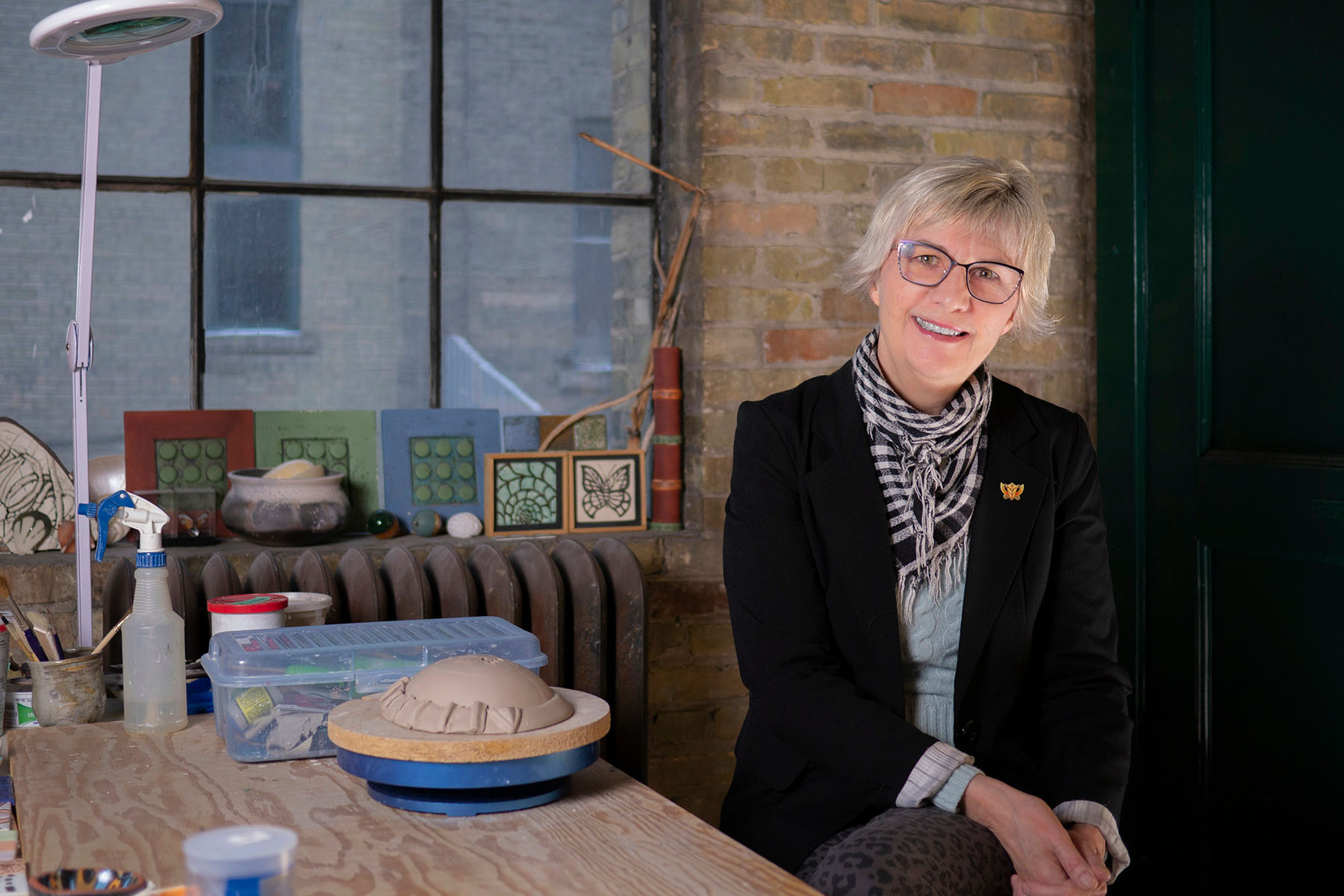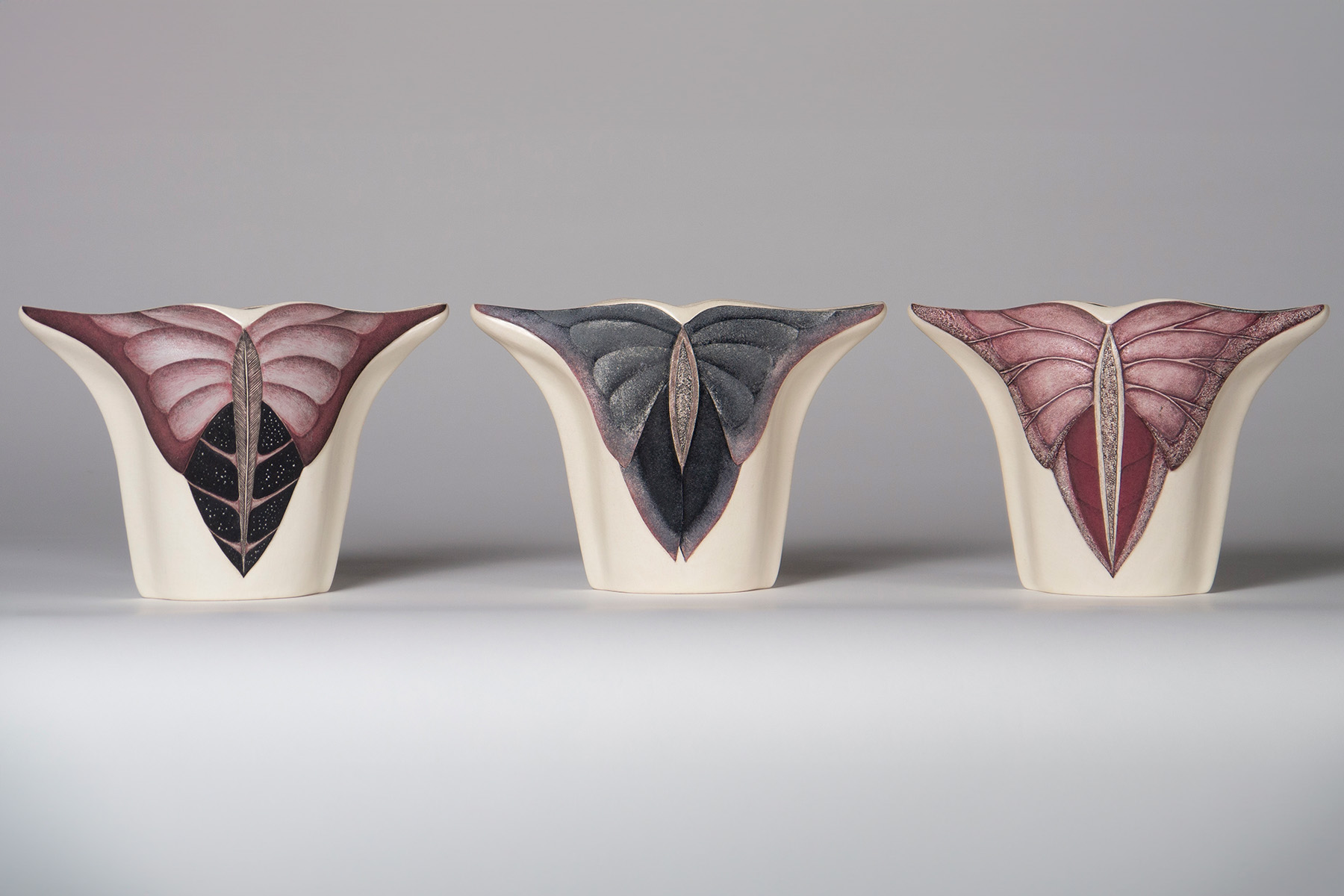There’s a multiplicity of layers to Grace Nickel’s work, literally and figuratively. Take, for instance, Arbor Vitae (2015), a remarkable installation by this acclaimed Winnipeg- based ceramic artist and educator.

At first glance, you see a series of stark, yet striking, porcelain sculptures that resemble tree limbs while evoking ancient architecture, like the colossal columns of Parthenon, and serving as a metaphor for the human body.
Look a little deeper and you’ll notice how the creations express Nickel’s extraordinary technical talent, recognized when she garnered the 2023 Saidye Bronfman Award, the Governor General’s Award for excellence in fine crafts. For Arbor Vitae, Nickel went beyond conventional ceramic methods and immersed herself in the inventive, such as the use of high-tech fabric formwork, employing textiles to create shapes and bark-like markings.
Delve even further and you’ll learn how the large-scale sculptures were built upon two years of rigorous study, experimentation, and travel (including an artist’s residency in Jingdezhen, the porcelain capital of China). For Nickel, whose also a professor at the University of Manitoba’s School of Art, such meticulousness is par for the course.
There’s a cerebral foundation to these sculptures, which is true of Nickel’s whole body of work, spanning roughly 40 years. “Often people talk about hands when you’re in a craft-related field, [but] there’s a zone I enter where I don’t think about my hands very much. So, in that sense, it’s way more ‘brain’ than ‘hands’ in the studio for me,” says Nickel, whose ceramics can be found in the permanent collections of institutions, like Taiwan’s New Taipei City Yingge Ceramics Museum and, in Japan, the Museum of Modern Ceramic Art, Gifu.
For Tammy Sutherland, the Manitoba Craft Council’s executive director, what sets Nickel apart is not only her conceptually driven artistry but also her incredible stamina for detail. “She’s a very unassuming kind of person, but she has a reputation for painstaking research and persistence in trying to explore new territory and techniques,” notes Sutherland, who nominated Nickel for the Saidye Bronfman Award. “There’s this exquisite level of craftsmanship that she brings to everything.”

Even some of Nickel’s earliest vessels involved “literally hundreds of layers of work,” Sutherland says — carving, drawing, painting, stippling, sandblasting, to name just a handful — and points to the Overlay series (1980s), which portrays moths and other forms of natural elements.Such diligence means that Nickel’s process tends to be slow-paced, allowing room to mediate on the themes most meaningful to her. Trees comprise one of the central fascinations for Nickel, though they were scarce in the landscape of her childhood. She grew up on a farm in Plum Coulee, a tiny community in the bare prairies of southern Manitoba. It was her time in Halifax, where she moved in 2006 to pursue her Master of Fine Arts at NSCAD University, that imprinted the motif on her creative psyche.
At the southern tip of the Halifax Peninsula, there’s a historic, beloved greenspace known as Point Pleasant Park. The 75-hectare wooded area, home to old-growth forest, was violently lashed by Hurricane Juan in 2003, with an estimated 70 percent of its trees destroyed. “Before I moved there, I had been told, ‘Oh, it’s all healed over. You won’t really even notice the devastation anymore.’ But I walked into it and I was overwhelmed,” Nickel recalls.
Many of the downed trees hadn’t been removed; rather, they were chopped up and left behind in a bid to help the forest regenerate. “I just couldn’t help but think of them as corpses,” says Nickel. The scene was potent proof of nature’s power to destroy and its ability to self-heal, slowly but surely.

Nickel was moved to create a tribute to Point Pleasant Park — Devastatus Rememorari (2008), her first large tree-inspired work. For the installation, she made casts of demolished tree remnants and transformed them into porcelain monuments. The slender trunks were embellished with text — with words like “devastated” and “remembered” (in Latin, devastatus and rememorari) — repeatedly, then arranged on a surface representing a salt-bed peninsula. “My work has always been commemorative,” Nickel explains. “I don’t think I knew that at first, but it’s just been a thread running through.”
To celebrate Nickel’s Saidye Bronfman Award win, Winnipeg’s WAG-Qaumajuq museum put on a show last year — “Inter Artes et Naturam (Between Art and Nature)” — as a small survey of the artist’s career and recurring themes.
“Nickel often references textures drawn from nature, especially trees, as a visual representation of the cyclical nature of the human body and human existence. Growth, decomposition, regeneration, regrowth — in Nickel’s work, this process is an aesthetic all its own and can be understood as a natural technology in itself,” notes Riva Symko.
What also truly sets Nickel’s studio practice apart, adds Symko, is her embrace of new technologies and methods to build on traditional and even ancient ceramic processes. “Walking through Nickel’s oeuvre, you can almost sense the clay dust of history from which her sculptural composites emerge like an innovative material force.”
Some of Nickel’s newer works were displayed from December 2023 until March 3rd of this year, at Ottawa’s National Gallery of Canada, as part of a showcase featuring artists who had won Governor General’s Awards. The exhibition included Eruptions, which Nickel debuted in 2019 but continues to evolve with added elements. The installation brings together contemplations of decay and regeneration, grief and hope.
Eruptions centre around a trio of Pyres, porcelain memorials of truncated tree trunks. Upon them sprout clusters suggest fungal growths or, in one case, funerary amphoras. Branching out from the pyres are long strands of ceramic-beaded Lifelines, stretching up to the wall — reminiscent of roots, veins or umbilical cords, they’re sources of nourishment and potential new life. In Nickel’s words, the works “stand in for what once was and become artifacts of the metamorphosis and history of a living [and dying] organism.”
Looking at Nickel’s body of work, one can’t help but think of catastrophe, from hurricane-wrought destruction to deforestation and wildfires. And yet, despite the haunting elements of her art, a sense of optimism endures.
“I don’t call myself an environmentalist, but I think now we kind of all are. We no longer have a choice,” says Nickel, whose home in Winnipeg is located within an urban park, allowing for peaceful forest walks, a ritual she describes as possibly her happiest.
In her studio, the world may melt away during her introspection, which frequently starts at a personal level. But her mind’s eye often expands to the world outside, to universal concerns. Gazing upon her art, absorbed in thought and feeling, the viewer is invited to do the same.
By Wing Sze Tang — *This article originally appeared in Insight: The Art Of Living Magazine – The Metamorphosis Issue.



